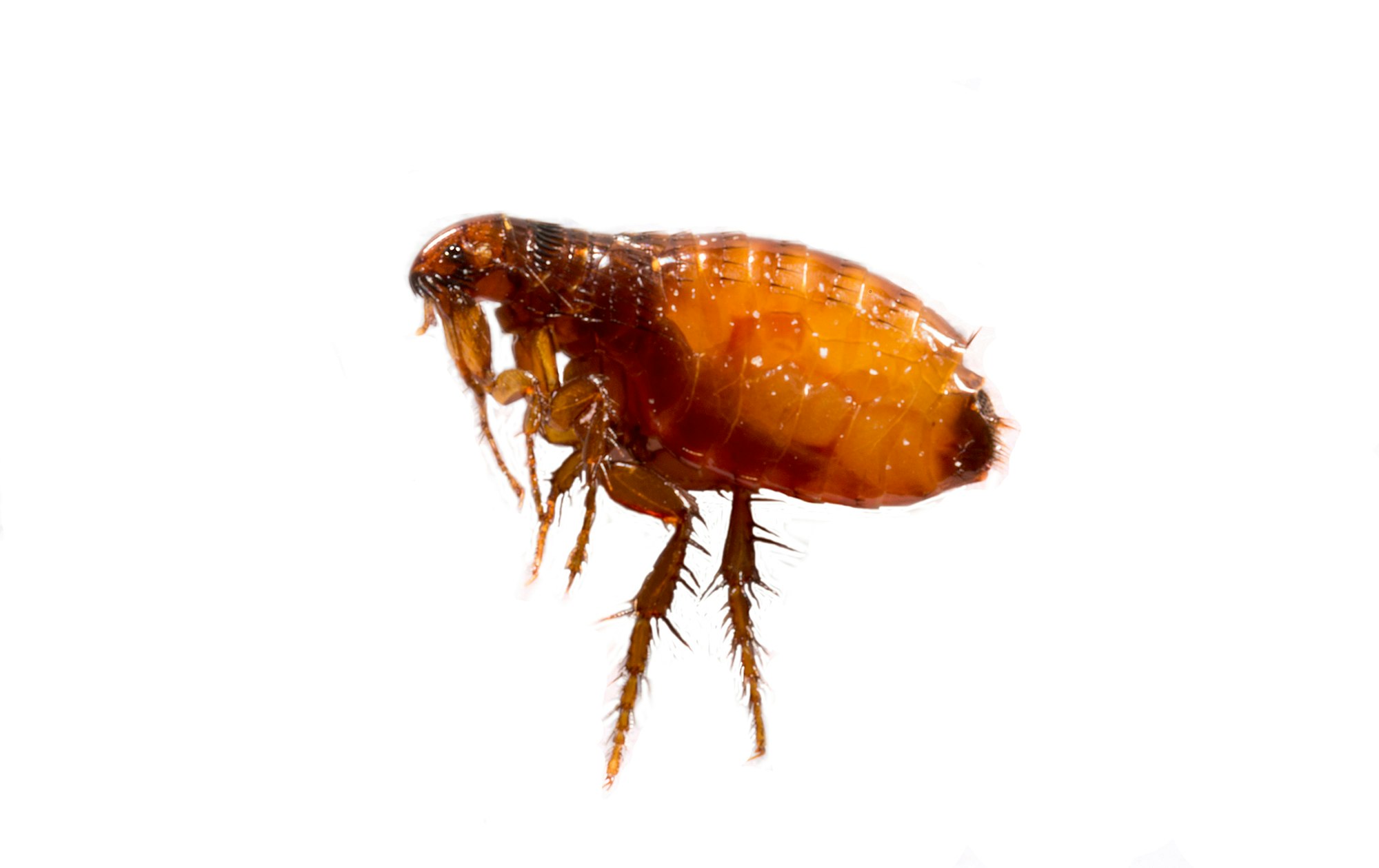Fleas

While the District doesn’t do residential or commercial pest control, we’re happy to help by identifying suspected flea specimens, conducting an inspection for wildlife or rodent problems that may be contributing to your problem, and providing advice for flea control in and around your home.
Most people have had an encounter with a flea at some point – the jumping black specks, the small itchy bumps they leave in their wake, and the general feeling of unease due to having a parasite in your home. However, few people understand the biology of fleas and why they invade our homes in the first place.
While most of us are familiar with the cat and dog fleas that plague our pets and ourselves, only a few species of fleas will bite a range of host species. This is because fleas are nest parasites, which means they live in the nests and homes of their hosts. Because of this, most fleas are “semi-host specific” and are rather choosy about what animals they will feed on. For example, there is a flea that specializes on woodrats (Orchopeas sexdentatus), and one that prefers American pika (Geusibia ashcrafti). While these fleas will take a blood meal from another species, they prefer not to and generally don’t survive well once separated from their preferred host. Large animals that don’t have nests, like deer, don’t usually have fleas at all, or only have fleas they picked up from other species.
Identification
Fleas are very small, dark-colored insects. They are capable of jumping long distances relative to their size; this behavior makes them easy to distinguish from specks of dirt, nymphal ticks, and other similar-size insects that don’t jump.
On your pet, you may notice scratching or other skin irritation, live fleas, or flea droppings, which look like small black granules.
Biology
Fleas must feed regularly in order to survive, although eggs and pupae can survive up to 12 months in a vacant nest until a new host arrives. This is why a vacant home can suddenly become infested when new residents arrive. When a flea first emerges as an adult, it must find its first blood meal within one week or it will starve to death. After this first blood meal, non-reproducing female and male fleas may survive without feeding up to 4 days but egg-laying adult females will die within 24 hours without a blood meal. This leaves very little time to find a new host if their old host is gone. This makes fleas critical in the transmission of plague: when rodents infected with plague die, their fleas are left without a host and will soon leave the rodent’s burrow in search of a new host – in some cases, a human walking nearby. While plague is rare in the United States (an average of only several are reported every year), it is seasonal and outbreaks can be detected in wild rodents from spring to early fall.
Risks
Fles are capable of transmitting disease to humans and pets, including rickettsiosis, typhus, and plague. These diseases aren’t common in San Mateo County, but contact with fleas should be avoided. Flea bites can also cause allergic reactions and skin irritation in both people and pets.
Control
Protect yourself from fleas by preventing infestations in your home. Apply flea medication to your pets, and keep cats indoors. When hiking or camping, avoid resting or setting up camp near rodent burrows or where there is high rodent activity. If fleas do infest your home, vacuum and wipe surfaces regularly to remove them. Consumer flea control products can be effective, but always read the label carefully and follow the directions.
Flea infestations can occur even in homes without pets; this most commonly occurs when wild or feral animals are making their dens under the home. These issues must be addressed at the same time as other flea control measures to avoid repeated infestations.
To prevent flea infestation, treat your pet with an appropriate flea preventative; ask your veterinarian is best for your pet. Many products designed for dogs cannot be used on cats. Both oral and topical products are available.
If your home is already infested with fleas, you will need to vacuum carpets, rugs, cushions, upholstered furnishing, and all crevices in the home. Wash your pet’s bedding, too. Focus on areas where you have been bitten by fleas or where your pet spends most of his time. You may have to do this regularly for some days or weeks to eliminate the infestation.
You may need to use an insecticide on infested carpets and furniture; as with any pesticide, you MUST read and follow the label to avoid harm to people, pets, or the environment. Make sure the product you choose is labeled for indoor flea infestations, and apply it only as directed. In most cases, you will not need to use an insecticide for fleas outdoors.
Sometimes flea infestations occur in homes without pets when wildlife make their dens in, under, or around the home. If you have repeated flea infestations despite following the above recommendations, consider contacting a licensed pest control company to help locate the source of the problem.
More Information
General information on fleas and flea control is available from the UC IPM program webpage. More information about flea control for pets is available from the American Veterinary Medical Association webpage.
Page last reviewed: October 9, 2025
